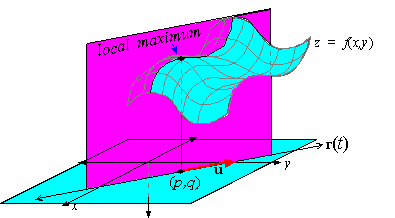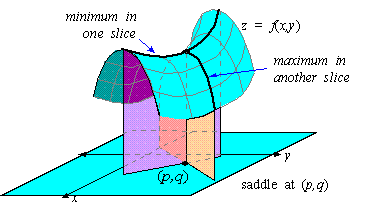The Second Derivative Test
Clearly, f( x,y) has a local maximum at a critical
point ( p,q) only if every vertical slice of z = f(x,y) has a maximum at ( p,q) .

Similarly, f( x,y) has a local minimum at a critical point ( p,q) only if every vertical slice of z = f( x,y)
has a minimum at ( p,q) .
However, it is possible for f( x,y) to have a minimum in one
slice and a maximum in another slice.

If this is the case, then we say that f( x,y) has a saddle at ( p,q) , because the resulting surface resembles a
saddle for a horse.
To determine if we get a maximum, a minimum, or a saddle point at a critical
point ( p,q) , consider the vertical slice z( t) = f( p+mt,q+nt) . Then x = p+mt and y = q+nt implies that
x' ( t) = m and y'
( t) = n. As a
result, the chain rule yields
|
|
dz
dt
|
= |
¶f
¶x
|
|
dx
dt
|
+ |
¶f
¶y
|
|
dy
dt
|
= mfx+nfy |
|
Moreover, m and n constant implies that
|
|
|
| |
|
|
m |
æ
è
|
|
¶fx
¶x
|
|
dx
dt
|
+ |
¶fx
¶y
|
|
dy
dt
|
ö
ø
|
+n |
æ
è
|
|
¶fy
¶x
|
|
dx
dt
|
+ |
¶fy
¶y
|
|
dx
dt
|
ö
ø
|
|
| |
|
| m( mfxx+nfxy) +n( mfyx+nfyy) |
|
|
Expanding and using the equality of the mixed partial derivatives then
yields
|
z"( 0) = m2fxx( p,q)+2mnfxy( p,q) +n2fyy( p,q) |
| (1) |
In elementary algebra, it is shown that an expression of the form am2+bmn+cn2 has the same sign for all m and n only if b2-4ac < 0. Thus, z"( 0) in (1) has the same sign for all m and n ony if
|
4[ fxy( p,q) ] 2-4fxx( p,q)fyy( p,q) < 0 |
|
This reduces to fxx( p,q) fyy( p,q) -[fxy( p,q) ] 2 > 0, which motivates us to define the
discriminant of f( x,y) to be
|
D( x,y) = fxxfyy-[ fxy] 2 |
|
Thus, f( x,y) has a maximum at ( p,q) if fxx( p,q) < 0 and D( p,q) > 0, a minimum at ( p,q) if fxx( p,q) > 0 and D( p,q) > 0, and a saddle at ( p,q) when z"(0) has different signs in different vertical slices, which is when D( p,q) < 0.
Second Derivative Test: If ( p,q) is a critical point
of a function f( x,y) whose second derivatives exist at ( p,q) , then
|
|
| |
If D( p,q) > 0 and fxx( p,q) > 0 |
|
| |
then f( x,y) has a local minimum at ( p,q) |
|
| |
If D( p,q) > 0 and fxx( p,q) < 0 |
|
| |
then f( x,y) has a local maximum at ( p,q) |
|
| |
| |
then f( x,y) has a saddle at ( p,q) |
|
| |
If D( p,q) = 0, then no information |
|
| |
about f( x,y) is obtained |
|
|
|
|
The second derivative test can be extended to functions of more
than one variable by noticing that the discriminant is the determinant of
the Hessian Hf( p,q) (see Maple worksheets for an
exploration of this idea).
EXAMPLE 2 Identify the extrema and saddle points of f(x,y) = x2-y2.
Solution: Since fx = 2x and fy = -2y, the only critical point
is ( 0,0) . However, fxx = 2, fyy = -2, and fxy = 0,
so that the discriminant of f is
|
D = fxxfyy-( fxy) 2 = ( 2) ( -2)-02 = -4 < 0 |
|
Thus, f( x,y) = x2-y2 has a saddle at ( 0,0) .
EXAMPLE 3 Find the extrema and saddle points of f(x,y) = x3-3xy+y3.
Solution: In example 1, we showed that the critical points of f
are ( 0,0) and ( 1,1) . Since fx(x,y) = 3x2-3y and fy( x,y) = -3x+3y2, the second
derivatives of f( x,y) are
|
fxx = 6x, fxy = -3, fyy = 6y |
|
Thus, the discriminant is
|
D( x,y) = ( 6x) ( 6y) -( -3)2 = 36xy-9 |
|
At ( 0,0) , we have D( 0,0) = 0-9 = -9 < 0. Thus, f
has a saddle at ( 0,0) . At ( 1,1) , we
have
|
D( 1,1) = 36·1·1-9 = 27 > 0 |
|
However, fxx( 1,1) = 6 > 0, so f has a local minimum
at ( 1,1) .
Check your reading: Does f( x,y) = x2+3xy-y2-2x-3y have any local extrema?


